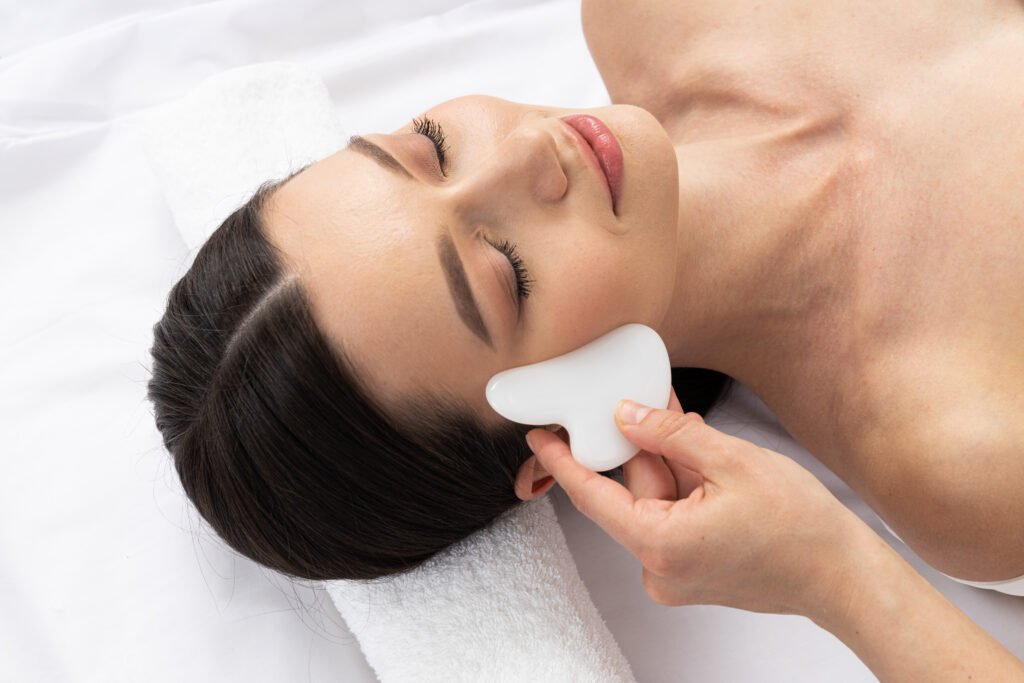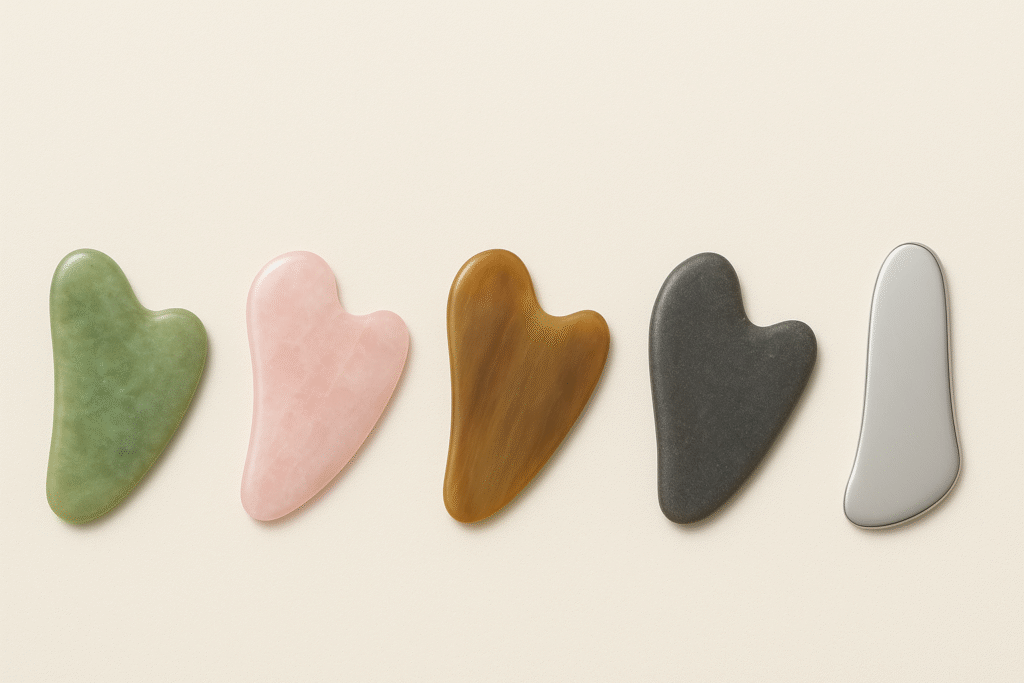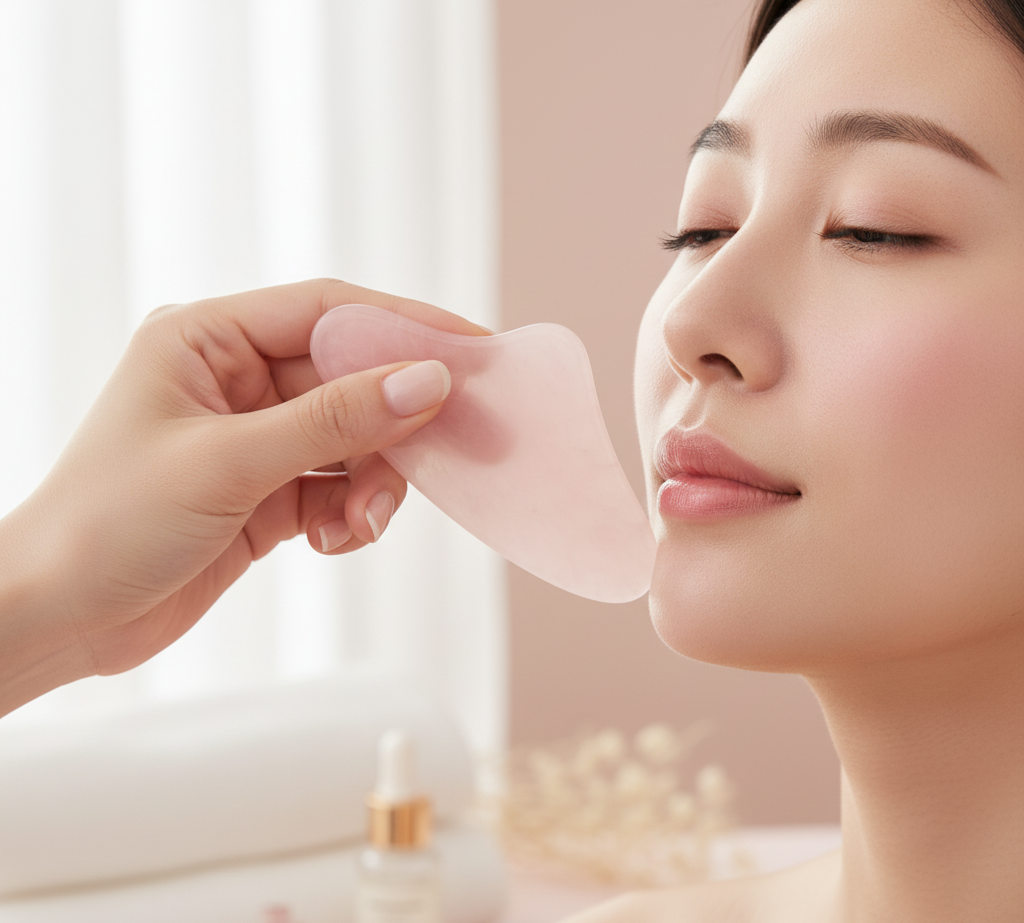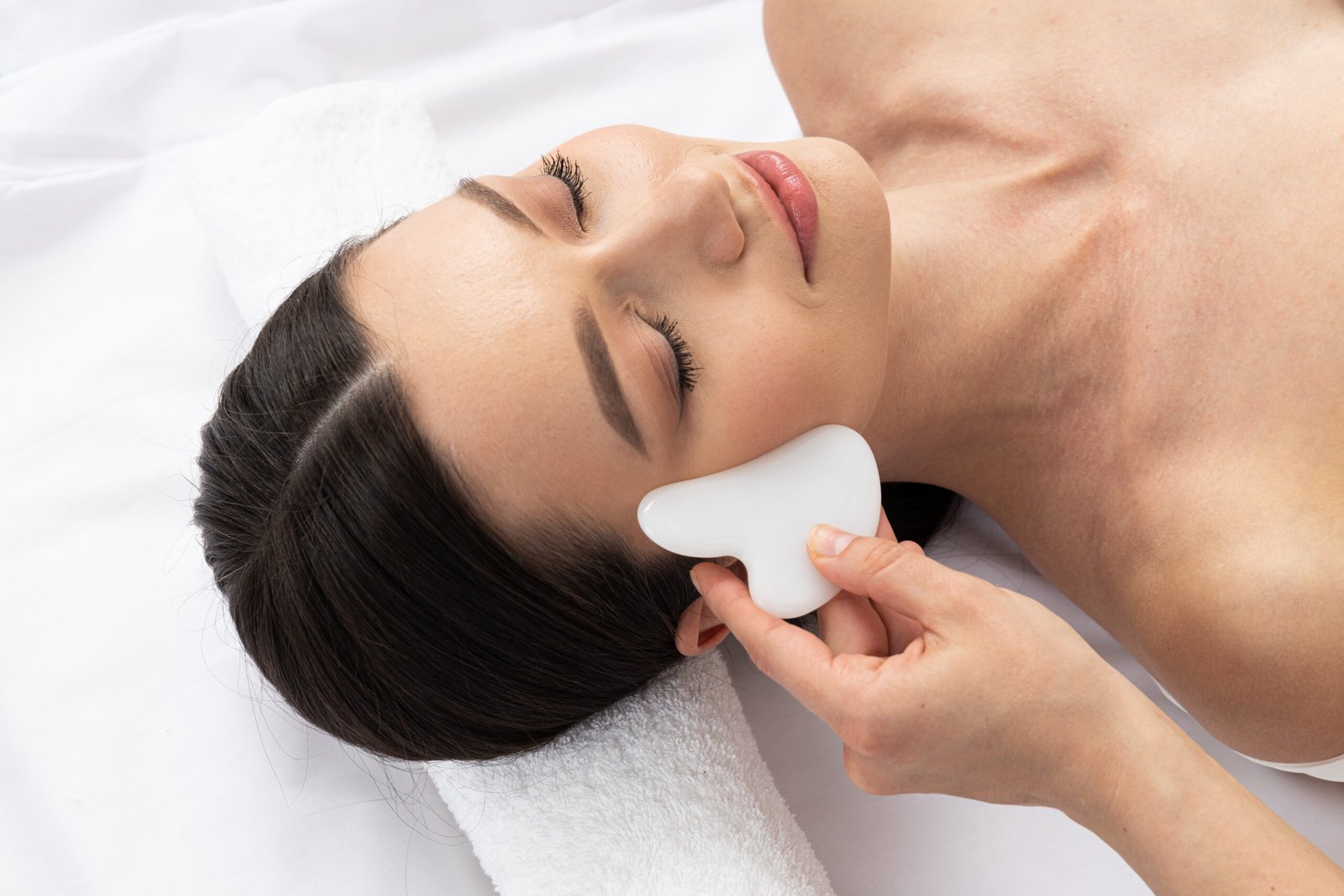1. Origins & Meaning

Gua Sha (刮痧; pronounced gwah-sha)—literally “scraping sha”—is a traditional East Asian healing practice. Its roots trace back to ancient China, with evidence of scraping techniques as early as the Paleolithic era and formal codification during the Ming Dynasty (1368–1644) (Wikipedia, n.d.; American Institute of Alternative Medicine [AIAM], 2018). In Traditional Chinese Medicine (TCM), “sha” refers to stagnation—of blood or qi—that must be released for health to be restored (Medical News Today, 2017; Wikipedia, n.d.).
2. Technique & Tools
Gua Sha involves the use of a lubricated, smooth-edged tool—commonly made from jade, rose quartz, buffalo horn, bian stone, or stainless steel—to scrape the skin in long, firm strokes along muscle groups or meridians (Medical News Today, 2017; Wikipedia, n.d.; Clayton Heights Chiropractic, 2023; Baylor Scott & White Health, 2022). Schooling in TCM emphasizes both the direction and pressure of strokes: lighter for facial use, firmer for musculoskeletal treatment (Wikipedia, n.d.; Medical News Today, 2017; Yoga Journal, 2021)

3. Alleged Benefits & Places of Use
Relief from Muscle & Joint Pain
Gua Sha is popularly applied for chronic neck or back discomfort, tendon strain, carpal tunnel, and other musculoskeletal issues. Some studies, including a systematic review and a randomized trial, indicate short-term pain relief and improved function (Medical News Today, 2017; Xu et al., 2011; Lee et al., 2021).
Lymphatic Drainage & Facial Renewal
Facial gua sha is believed to de-puff, contour features, and boost lymphatic flow and vascular response, though most of the evidence remains anecdotal or based on small-scale studies (Medical News Today, 2017; Healthline, 2017; Yoga Journal, 2021; Allure, 2020).
Immune & Inflammatory Support
TCM theory posits that gua sha helps move stagnated blood and qi, thus reducing inflammation. Some research suggests it may enhance microcirculation and immune response, though findings remain preliminary (Medical News Today, 2017; Healthline, 2017; Health, 2023; Li et al., 2023).
TMJ Relief
Some anecdotal and review-based evidence indicates gua sha may ease symptoms of temporomandibular joint (TMJ) disorders—like jaw tension and pain—though more comprehensive research is needed (Medical News Today, 2017).
Other Uses
Additional applications sometimes include easing cold or fever symptoms, digestive or respiratory issues, menstrual discomfort, perimenopausal symptoms, and even breast engorgement in nursing mothers (Health, 2023; AIAM, 2018).
4. Risks, Safety & Scientific Standing

Though gua sha is often considered low-risk, it essentially induces minor skin trauma—visible as petechiae or bruising (known as “sha”)—which can take a few days to a week to heal (Medical News Today, 2017; Wikipedia, n.d.; Health, 2023). Potential side effects include broken skin, infection if tools are unsterilized, and contraindications for individuals on blood thinners or with clotting disorders, skin conditions, or implants (Medical News Today, 2017; Clayton Heights Chiropractic, 2023; Health, 2023).
Moreover, the scientific community often regards gua sha as a pseudomedicine—highlighting that while it may offer symptomatic relief, the breadth of claimed benefits is not substantiated by rigorous evidence, and rare but serious complications have been reported (Wikipedia, n.d.; Xu et al., 2011; Medical News Today, 2017).
5. Expert Voices & Modern Perspectives
- Sandra Chiu, a seasoned TCM practitioner, stresses maintaining gua sha’s therapeutic integrity amid its social media popularity:
“I am working hard to put the TCM back in gua sha… Without accurate representation of this technique, it becomes known as a trendy beauty hack rather than a profound healing technique with a history that goes back centuries” (Allure, 2020).
- Ervina Wu and Angela Chau Gray of YINA recommend full-body use to promote chi circulation, emphasize adaptation to individual needs, and stress the importance of proper technique and authentic tools (Yoga Journal, 2021).

References
Allure. (2020, July 29). What is gua sha? Experts explain the Chinese medicine practice behind the beauty trend. Condé Nast. https://www.allure.com/story/gua-sha-chinese-medicine-uses
American Institute of Alternative Medicine. (2018, October 16). The benefits of gua sha. AIAM. https://www.aiam.edu/massage-therapy/benefits-of-gua-sha/
Baylor Scott & White Health. (2022, September 6). Gua sha: The Chinese facial tool for healthy skin and pain relief. https://www.bswhealth.com/blog/gua-sha-the-chinese-facial-tool-for-healthy-skin-and-pain-relief
Clayton Heights Chiropractic. (2023, September 11). Gua sha: Traditional Chinese method. https://claytonheightschiropractic.com/2023/09/gua-sha-traditional-chinese-method/
Health. (2023, June 6). What is gua sha, and does it work? Dotdash Meredith. https://www.health.com/gua-sha-7253778
Healthline. (2017, November 22). Gua sha: Benefits and risks. https://www.healthline.com/health/gua-sha
Lee, M. S., Choi, T. Y., Kang, J. W., & Ernst, E. (2021). Gua sha for musculoskeletal pain: A systematic review of randomized clinical trials. Journal of Traditional and Complementary Medicine, 11(5), 500–508. https://pmc.ncbi.nlm.nih.gov/articles/PMC8483130/
Li, X., Zhang, Y., & Wang, J. (2023). Effects of gua sha on microcirculation and immune function: A review. Biomedical and Environmental Sciences, 36(5), 449–456. https://www.besjournal.com/fileSWYXYHJKX/journal/article/swyxyhjkx/2023/5/PDF/22202.pdf
Medical News Today. (2017, December 21). What is gua sha?. https://www.medicalnewstoday.com/articles/320397
Wikipedia. (n.d.). Gua sha. In Wikipedia. Retrieved September 9, 2025, from https://en.wikipedia.org/wiki/Gua_sha
Xu, J., Deng, H., Shen, X., & Xu, Y. (2011). Gua sha therapy for chronic neck pain: A randomized clinical trial. Pain Medicine, 12(3), 362–369. https://doi.org/10.1111/j.1526-4637.2011.01065.x
Yoga Journal. (2021, January 27). Your complete guide to gua sha. https://www.yogajournal.com/lifestyle/fashion-beauty/natural-beauty/guide-to-gua-sha/

